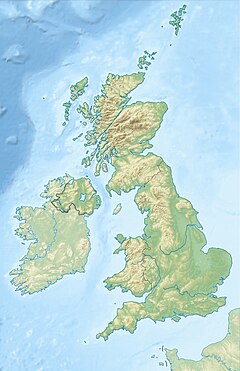Robin Hood's Ball
| UNESCO World Heritage Site | |
|---|---|
| Location | United Kingdom |
| Coordinates | 51°12′46″N 1°51′18″W / 51.2128°N 1.855°W |
| Criteria | i, ii, iii |
| Reference | 373 |
| Inscription | 1986 (10th Session) |
|
[]
|
|
Robin Hood’s Ball is a Neolithic causewayed enclosure on Salisbury Plain in Wiltshire, England. It is approximately 5 miles (8 km) northwest of the town of Amesbury, and 2 1⁄2 miles (4.0 km) northwest of Stonehenge. It was formerly known as Neath Barrow.
The site was designated as a scheduled monument in 1965.
Robin Hood’s Ball, despite the name, is entirely unrelated to the famous folklore hero Robin Hood. 19th century maps indicate that Robin Hood’s Ball was the name given to a small circular copse of wood just to the north west of the earthworks; it is probable that over time the name came to be associated with the enclosure instead. Greenwood's map of 1820 shows the copse named as Robin Hood's Ball and the enclosure named as Neath Barrow.
A causewayed enclosure consists of a circuit of ditches dug in short segments, leaving ‘causeways’ passing between them to the centre. Whilst some have three or four causeways, Robin Hood’s Ball has only one, cutting through two circuits of ditches with some low banks behind them. If it is assumed that the area was free of woodland in the Neolithic period, then its position on a low hill would have afforded clear views of the Plain in all directions, and the site of Stonehenge would have been visible, although it is likely that the enclosure predates it by some time.
Robin Hood's Ball is located just outside the northern boundary of the Stonehenge World Heritage Site but is listed as an associated site by UNESCO.
Robin Hood’s Ball is a Neolithic feature that dates from the earliest developments around the plain. It was probably constructed at around 4000 BC and in use possibly up to 3000 BC. When first constructed, none of the monuments to the south such as the Stonehenge Cursus, Durrington Walls, or even Stonehenge itself had yet been constructed. However, there may have been a henge at Coneybury, 1 mile east of Stonehenge, and it is possible that there were earlier features at Stonehenge before the bank and ditch was dug, as indicated by the Mesolithic postholes found in the area now under the car park. Several long barrows were constructed on the Plain around the same time, including one close to the Ball and several more within short distances such as White Barrow and Winterbourne Stoke Long Barrow. It is estimated that the site began to fall out of use around 3000 BC, about the same time as the earliest earthworks at Stonehenge (itself originally a causewayed enclosure) began.
...
Wikipedia

